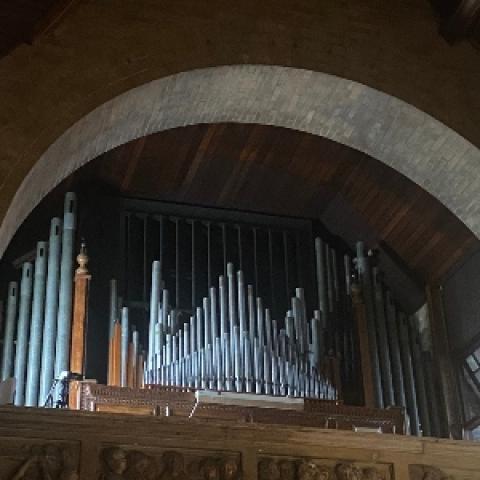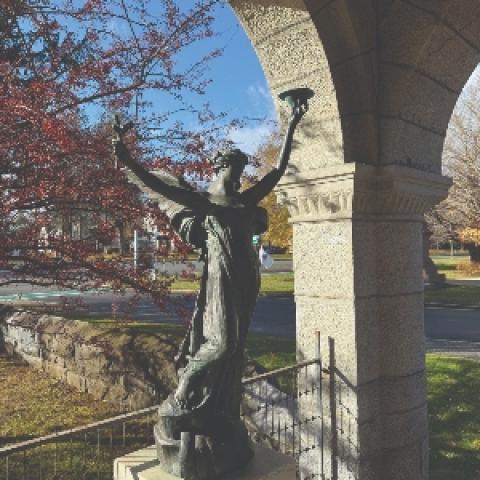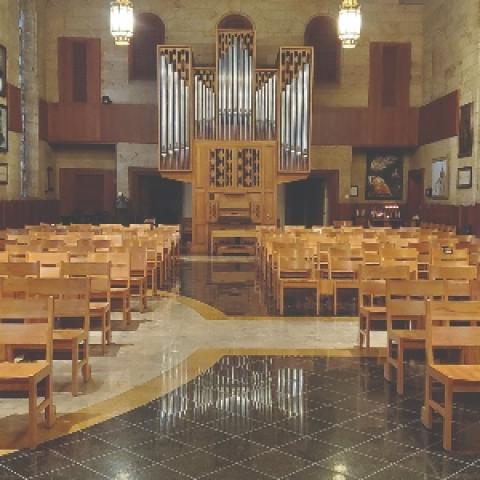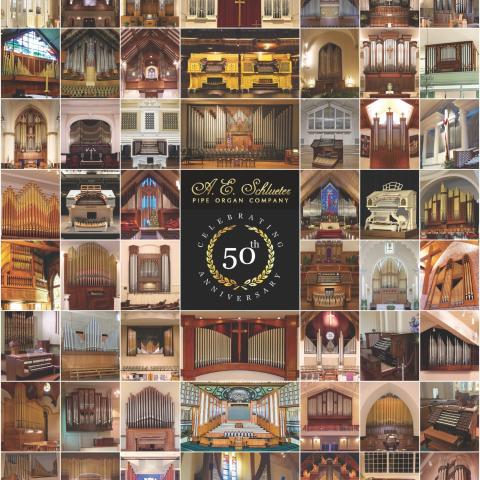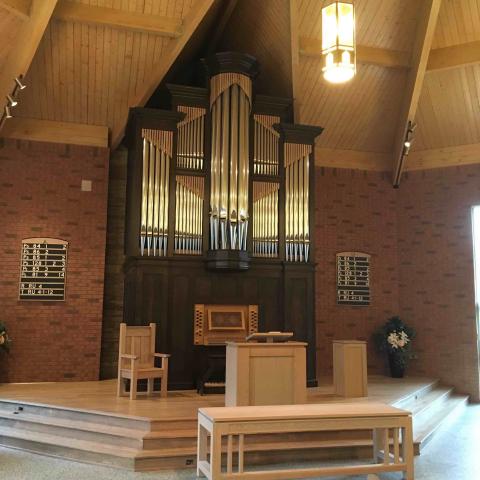Joyce Johnson Robinson is a past editor of The Diapason.

The Diapason’s 20 under 30 winners represent leaders not only in performance (organ, harpsichord, carillon, and church music), but also those who build, restore, and maintain instruments. In our first interview with a young builder, we find out more about Nicholas Wallace, of The Diapason’s inaugural 20 under 30 Class in 2015.
Nicholas Wallace holds a bachelor’s degree in classical guitar performance, graduating with honors from the Osher School of Music at the University of Southern Maine, Portland. Though he grew up in the organ business, it was after graduating from college that Nick joined David E. Wallace & Co. full time. As the junior partner, Nick now runs many aspects of the business, but focuses on visual and mechanical design, shop production, and general project management.
Leading Wallace & Co. of Gorham, Maine, into a new generation, Nick has expanded the shop’s capability to build new mechanical-action organs alongside the detailed restorations of nineteenth-century tracker organs that Wallace & Co. has built a reputation for over the last four decades. Nick is a member of the Organ Historical Society and is a board member of the American Institute of Organbuilders.
Nick, you grew up within organbuilding. Did your father inspire you to work as an organbuilder? How did your father get you started?
My grandparents were musicians and my great-grandmother was a church organist her whole life. That had a considerable influence on my dad when he was growing up. Like many kids back then, he took piano lessons, which eventually turned into organ lessons. Dad and my uncle attended concerts with my grandfather on the famous Kotzschmar Organ in Portland City Hall in the 1960s. Having the opportunity to see this major instrument inside and out was a considerable inspiration for Dad. While he was in college, he apprenticed with a Boston-area organ shop and began to learn the details of organ restoration and new organ construction.
One story Dad likes to tell is that when he was eleven years old, my great-grandmother asked him to go with her to the New Gloucester, Maine, Congregational church to play a memorial service for a friend. At that time in 1961 the George Stevens organ was still hand-pumped, which became Dad’s task for the service. This Stevens organ has had a definite influence on me and the tonal direction for Wallace & Co. Its modest scaling and colorful voicing paired with its historic unequal temperament make for a very charming instrument. The restorative work in both 1999 and 2020 along with the documentation of this Stevens organ serve as inspiration to the physical and tonal design of our new organs, in particular our Opus 78 in Ancaster, Ontario. (See “New Organs,” November 2020, page 13.)
During the 2023 pre-Christmas tuning season I had the pleasure of tuning dozens of organs that I have known my entire life. As I was up in the organs tuning rank after rank I could remember back to times when I was young enough that Dad would have to reach over to the end of the chest to pull a slider because the stop knob was too high on the stop jamb for me to reach.
Your degree is in classical guitar performance. Tell us about that.
I grew up in the classical music and organ music worlds, but studying classical guitar in college helped refine my musicality. While in college I focused on the music of South American composers like Heitor Villa-Lobos, Agustín Barrios, and Astor Piazzolla, no doubt a rebellion against the European music I had always known! Like the other plucked string instruments, as soon as you strike a note on the guitar the sound starts to fade. To deal with this issue I spent many guitar lessons discussing articulation and dynamics to best shape phrases. Midway through college I began organ lessons as well. Once again, these same ideas were front and center. Studying the two instruments simultaneously was very beneficial in this respect even though the two instruments are otherwise very different.
An important lesson that I learned from the guitar is the power of playing softly. Because of the size of the guitar and the immediate decay of the notes, even at its loudest the guitar is a quiet instrument. I am quick to notice during any performance how quiet the audience becomes and how carefully they tend to listen. I always remember this influence when designing an organ. Louder and more colorful stops are indispensable for leading singing and playing repertoire, but the more delicately voiced stops are of great importance, particularly in smaller instruments.
Did your organ study with Harold Stover and Ray Cornils influence your work in organbuilding and restoration? In what way?
Absolutely. Reading through and practicing a little of the repertoire, some hymns, and discussing the basics of playing has come in handy on a near-daily basis. It’s always helpful to get more insight into what organists need and why.
E. & G. G. Hook & Hastings Opus 845, a single-manual, two-rank instrument from 1876, resided in your family’s home for some years. Did this spur your interest in pipe organ construction?
I see this organ every day in the shop. It is interesting in that it was built by E. & G. G. Hook & Hastings as a sort of “portable” organ as it disassembles into several large pieces. Subsequently, I have had the chance to move this organ into several locations. I believe this design helped to influence Dad when he built the educational “Kotzschmar Jr.” organ for the Friends of the Kotzschmar Organ. Kotzschmar Jr. comes apart into four major sections and can fit in a minivan.1 Also inspired by this “portable” construction is my design for Wallace & Co. Opus 73. This organ is the performance counterpart to Kotzschmar Jr. and has a little more variety than Hook Opus 845 with three-and-a-half stops.
You worked with C. B. Fisk, Inc., during your college years on the installation of their Opus 130 in Costa Mesa, California—a much larger instrument than Hook Opus 845! What did you learn from this experience?
Working with Fisk was a great experience, and there was much to learn. Fisk Opus 130 is a very large instrument, but even by that time, I had spent years with the Kotzschmar Organ in Merrill Auditorium. I spent three weeks out in California for that installation, and the very last thing that I did was install the Great and Positive keyboards. That installation was my first experience with carbon fiber trackers. To this day Wallace & Co. is still making our own wooden trackers, but with some larger projects on the horizon, perhaps we will join in all the fun soon. Someday I will have to go visit Fisk Opus 130 to see what it is like.
Do you have a library of books on organbuilding? Which ones do you consult?
In recent years I have done my best to add to the library in the organ shop. On most days if we are looking something up, given the nature of our work we will likely reach for Audsley or Dom Bédos. Years ago, we took over the contents of a colleague’s shop and ended up with piles of past publications from the International Society of Organbuilders. There is a wealth of informative articles about every aspect of organ building in these journals written by different organ builders from around the world.
In recent years I have made a point to document the old organs that Wallace & Co. has restored. This usually amounts to careful measurements of the pipework and notes about the key action and any other interesting information. The data from all this documentation work is also something that we regularly reference. In 2021 Nami Hamada (now the tonal director at C. B. Fisk) and I began the ongoing documentation of E. & G. G. Hook Opus 288 at Saint John’s Catholic Church in Bangor, Maine.
You designed an organ for Saint Paul’s Anglican Church in Brockton, Massachusetts, at a rather young age. What was that experience like, and what did you learn from it?
I had to go back and check, but yes, twenty-four is young for that sort of responsibility these days. When we started Opus 66 in 2010, I had been working in the shop for ten years. Most aspects of this project were not new to me. For years I had been making and restoring wind systems, key and stop actions, and slider windchests. In 2009 I built my first case for Wallace & Co. Opus 62, for the Congregational Meetinghouse of Perry, Maine. Looking back, I can see that all the work prior to 2010 was a natural progression to the design and construction of my first complete instrument.
In the process of designing and building I was certainly not alone. Mechanically and structurally the organ bears a great resemblance to the smaller organs of Hook & Hastings. The two-division, single-grid slider chest, the simple backfall design of the key action, and the double-rise reservoir are all directly inspired by several small Hook & Hastings organs that I had worked on. Tonally the organ takes cues from the work of George Stevens in the 1850s with the scaling of the Great 8′ Chimney Flute and the 4′ and 2′ principals mirroring the 1857 George Stevens organ that I mentioned earlier. I also had my dad in the shop and other colleagues with whom to discuss certain design elements. Opus 66 has served well for the past thirteen years, and the organ has been a pleasure to visit for semi-annual tunings.
Wallace & Co. has done several international projects. What brought you to doing international projects, and did you find the experience rewarding?
Two of my favorite projects have been Wallace & Co. Opus 78 for the Ancaster Canadian Reformed Church in Ancaster, Ontario, and the restoration and relocation of E. & G. G. Hook Opus 173 for the Church of Our Lady and Saint Rochus in Boom, Belgium. These international experiences were rewarding and career broadening in ways that I’m still discovering to this day. My first international project was the restoration and installation of Hook Opus 173 in Boom, Belgium. The late Gerard Pels, a Belgian organbuilder, was working as a consultant for the church when he saw our listing of the Hook organ for sale. The 1854 date of the organ and its Gothic-style case matched the date and architecture of the church perfectly. Pels asked if we would be willing to restore and then install the organ in Boom. After a little research, we agreed to do the project. I worked all summer and then took a semester off from the university to join the crew for the installation. During the first week of installation the Pels crew assisted us with unloading the shipping container and the beginning of the installation. Even with our limited Dutch and their limited English, we all had a great first week sharing our organ stories over lunch or while assembling parts of the organ.
The other international venture was Wallace & Co. Opus 78 for the Canadian Reformed Church in Ancaster, Ontario, where the project involved building a new two-manual, twenty-seven-rank organ for the church. To date, this is the largest new organ designed and constructed by Wallace & Co. Just like our Opus 66 in Brockton, Massachusetts, so many of my previous projects led to the design of this unique organ. As has been typical, my design for this organ leaned towards the more traditional in its appearance, its actions, and its sound. All mechanical systems within the organ, the key action, stop action, and wind system draw inspiration from historical designs with some modern materials used. The project was very successful and has brought great support to the church’s worship services. We consider that the project was one of our most successful for the design and construction of a new organ.
Working with the church leaders, musicians, and organbuilding colleagues in different countries was a great experience, and I learned a lot. It is no surprise that any church that adds a pipe organ to their music program and worship experience is the same, no matter how many borders you cross. They want a top-quality instrument that meets or surpasses their musical needs now and well into the future.
Do you prefer to create new instruments or do restorations?
I enjoy both new and old instruments. I do not think that it is necessary for organbuilders to only do one or the other. In fact, I find it quite beneficial to do both. The attention to detail, knowledge of mechanics, and the organizational skills required to build new organs greatly improves a restoration. Likewise, the historical knowledge and respect for past building methods gives greater depth to the design of a new organ. The study of older organs can also serve as a wonderful source of inspiration in new organ designs.
What are your recent projects?
The last few projects have been a series of Hook & Hastings organs. In March of 2023 we finished the installation of Hook & Hastings Opus 1192 at Saint Alban’s Episcopal Church in Staten Island, New York. This was a top-to-bottom restoration where we carefully cleaned and restored all parts of the organ. The wind system received new feeder bellows and a new hand pump mechanism. The new hand pump system, which was designed based on the documentation of other period instruments, provides a smooth and quiet alternative to the blower, which can also be used.
At the end of May 2024 we completed the restoration of Hook & Hastings Opus 1763 for Saint James Episcopal Church in Prouts Neck, Maine. This project required more re-creation than other projects as most of the original Hook pipework had been discarded in the 1970s. Based on the remaining original pipework we were able to scale new pipework to return the organ to its original voice.
How did the Saint James restoration turn out?
Opus 1763 is now done and in use for their summer 2024 season. It has been a real pleasure to return this organ to its original specification and scale. Saint James is a coastal summer chapel, with picturesque views of the Maine coast and is just across the road from the Winslow Homer Museum. Members at Saint James have begun planning a series of events featuring the organ.
And the latest project?
On June 3, we began our next major project, which is the complete restoration of Hook & Hastings Opus 1487 at Saint Joseph’s Catholic Church on Capitol Hill, Washington, D.C. Thanks to good stewardship and some great restorative work in the 1980s by George Bozeman, this Hook organ is in near original form. Like our other recent restorations, we will carefully restore each piece of the organ and bring it to like-new condition. This organ will also receive a renovated hand pumping system and a new 16′ Posaune in the Pedal modeled after period Hook pipework.
I am also excited to share the news that Wallace & Co. has signed a contract for our Opus 81 with Saint Stanislaus Catholic Church of Nashua, New Hampshire. The new mechanical-action organ will feature thirty-two stops over two manuals and pedal. We are looking forward to beginning work on Opus 81 in mid-2025.
What do you like best about the work you do?
I like that no two projects are alike. Of course, there are a lot of similar things; we do our fair share of Hook restorations. But even within that portion of the business, there is great variety. And then there is all kinds of fun in designing a new instrument. The freedom to take inspiration from past work and incorporate it into something new is always a thrill.
Thank you, Nicholas.
Notes
1. See thediapason.com/friends-kotzschmar-organ-launches-kotzschmar-kids. Accessed on February 9, 2024.


